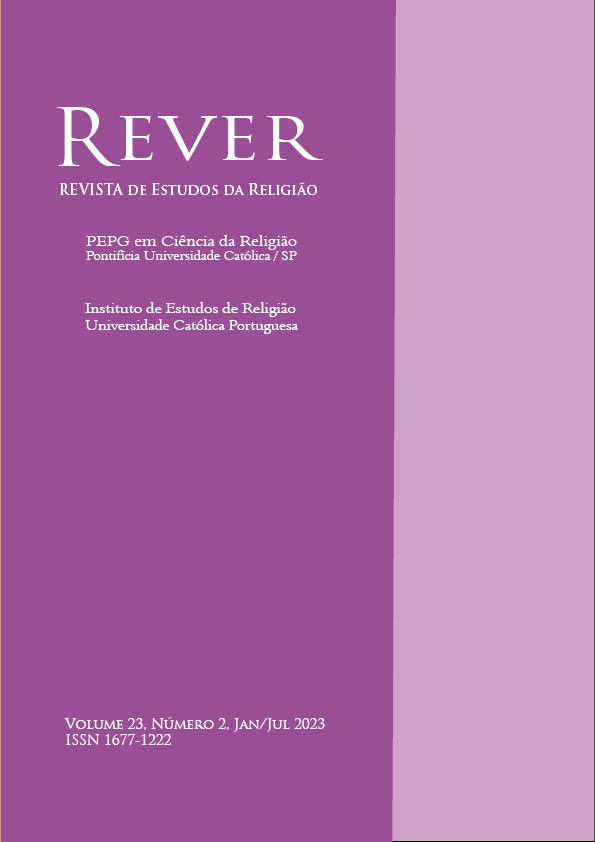O inferno carnavalizado da “Visão de Túndalo”
DOI:
https://doi.org/10.23925/1677-1222.2023vol23i1a3Palavras-chave:
Túndalo, Inferno, CarnavalResumo
O presente artigo apresenta uma introdução ao texto medieval A “Visão de Túndalo”, uma descrição do contexto de seu surgimento e de seu gênero discursivo e uma reflexão teórica sobre o seu conteúdo a partir do conceito bakhtiniano de carnavalização e de outros de abordagem histórica que fazem parte da reflexão de estudiosos que descrevem a cultura popular medieval e os fenômenos correlacionados a esse texto. Delimita-se exclusivamente a parte da “Visão de Túndalo” que narra a passagem do visionário pelo inferno. Destaca-se, neste estudo, o aspecto sincrônico e a discussão proposta aplica-se sobre a profundidade do imaginário, sobre o fenômeno cultural que se manifesta na narrativa. Do ponto de vista cultural cassireriano, no qual Bakhtin se fundamenta, textos desse gênero, muito comuns na Idade Média, representam um recurso simbólico para superação do medo da morte, que, intrinsecamente, faz parte da cosmovisão do ser humano dotado de cultura.
Referências
ARIÈS, Philippe. História da morte no Ocidente. Rio de Janeiro: Nova Fronteira, 2012.
ARIÈS, Philippe. O Homem diante da morte. Rio de Janeiro: Edusp, 2014.
BAKHTIN, Mikhail Mikhailovitch. Cultura popular na Idade Média e no Renascimento: o contexto de François Rebelais. São Paulo: HUCITEC, 2010a.
BAKHTIN, Mikhail Mikhailovitch. Problemas da poética de Dostoiévski. Rio de Janeiro: Forense Universitária, 2010b.
BAKHTIN, Mikhail Mikhailovitch. Os gêneros do discurso. São Paulo: Editora 34, 2016.
BÍBLIA SAGRADA. JFARA. Barueri: Sociedade Bíblica do Brasil, 1999.
BRANDIST, Craig. Repensando o círculo de Bakhtin. São Paulo: Editora Contexto, 2012.
BURKE, Peter. Cultura popular na Idade Moderna. São Paulo: Companhia das Letras, 2018.
CASSIRER, Ernst. A filosofia das formas simbólicas II: o pensamento mítico. São Paulo: Martins Fontes, 2004.
DELUMEAU, Jean. História do medo no Ocidente 1300-1800: uma cidade sitiada. São Paulo: Companhia das Letras, 2009.
ECO, Umberto. Los marcos de la “libertad” cómica. In: ECO, Umberto; IVANOV, Valentin; RECTOR, Monica. ¡Carnaval! Tezontle: Fondo de Cultura Económica, 1989.
GINZBURG, Carlo. O queijo e os vermes: O cotidiano e as ideias de um moleiro perseguido pela Inquisição. São Paulo: Companhia das Letras, 2006.
GUREVICH, Aaron. Bakhtin e sua teoria do carnaval. In: BREMMER, Jan; ROODENBURG, Herman (orgs.). Uma história cultural do humor. Rio de Janeiro: Editora Record, 2000, pp. 83-92.
GUREVICH, Aaron. Medieval popular culture: problems of belief and perception. New York: Cambridge University Press, 1988.
HOMERO. Odisseia. Rio de Janeiro: Nova Fronteira, 2011.
LE GOFF, Jacques. O nascimento do Purgatório. Petrópolis: Vozes, 2017.
LIMA JUNIOR., José. Humorte: cosquinhas semióticas no umbigo da entropia. Piracicaba: Editora UNIMEP, 2001.
MORSON, Gary Saul; EMERSON, Caryl. Mikhail Bakhtin: criação de uma prosaística. São Paulo: Edusp, 2008.
PEREIRA, F. H. Esteves (Ed.). “Visão de Túndalo” (Códice 244). In: Revista Lusitana Vol. III, 1895, pp. 97‐120.
RENFREW, Alastair. Mikhail Bakhtin. São Paulo: Parábola, 2017.
VILLAR VERDE, Patrícia (Ed.). “Visão de Túndalo” (Códice 266). In: Revista Lusitana N. s., 4, 1982-1983, pp. 38‐52.
VIRGÍLIO. Eneida. Estudo introdutivo de Paulo Rónai. São Paulo: Ediouro, 1991.
ZUMTHOR, Paul. Falando de Idade Média. São Paulo: Perspectiva, 2009.
ZUMTHOR, Paul. Performance, Recepção, Leitura. São Paulo: Ubu Editora, 2018.
Downloads
Publicado
Como Citar
Edição
Seção
Licença

Este trabalho está licenciado sob uma licença Creative Commons Attribution-NonCommercial 4.0 International License.
Autores que publicam nesta revista concordam com os seguintes termos:
- Autores mantém os direitos autorais e concedem à revista o direito de primeira publicação, com o trabalho simultaneamente licenciado sob a Licença Attribution-NonCommercial 4.0 International, que permite o compartilhamento do trabalho com reconhecimento da autoria e publicação inicial nesta revista.
- Autores têm autorização para assumir contratos adicionais separadamente, para distribuição não exclusiva da versão do trabalho publicada nesta revista (ex.: publicar em repositório institucional ou como capítulo de livro), com reconhecimento de autoria e publicação inicial nesta revista.


